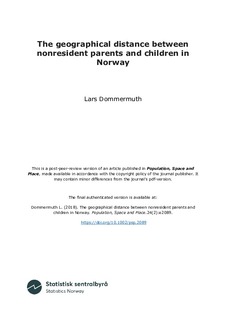| dc.contributor.author | Dommermuth, Lars | |
| dc.coverage.spatial | Norge / Norway | nb_NO |
| dc.date.accessioned | 2019-03-01T15:55:09Z | |
| dc.date.available | 2019-03-01T15:55:09Z | |
| dc.date.issued | 2017-08-25 | |
| dc.identifier.citation | Dommermuth L. (2018). The geographical distance between nonresident parents and children in Norway. Population Space and Place, 24(2), e2089. | nb_NO |
| dc.identifier.issn | 1544-8452 | |
| dc.identifier.uri | http://hdl.handle.net/11250/2588344 | |
| dc.description.abstract | As union dissolution rates increase in most modern societies, a growing number of children are living in post‐separation families. The geographical distance between parental households shapes the possibilities for contact between nonresident parents and children, but empirical studies are lacking. This study investigates the geographical distance between nonresident parents and children in Norway using a total population sample, including exact geographical coordinates for residency. Results show that most children are registered in the maternal household, indicating a strong social norm favouring motherhood after union dissolution. The majority of nonresident parents live within a 10‐km radius of their child, but the average distance is greater for nonresident fathers than for nonresident mothers. Multilevel analysis show that the distance between the parental households decreases with regional level of urbanisation. There is evidence that the distance between the two parental households is greater if the child was either relatively young or old at parents' union dissolution. Parents' income at this time is negatively correlated with distance. This underlines the long‐lasting impact of family characteristics at the time of parents' union dissolution on subsequent residential moves. Also different events after parents' union dissolution are associated with the geographical distance between nonresident parents and children. Time since the break‐up, the formation of a new coresidential union, and the birth of subsequent children are positively correlated with the distance between the two parental households. If children move from one parental household to the other, this is associated with longer distances, especially to nonresident mothers. | nb_NO |
| dc.language.iso | eng | nb_NO |
| dc.publisher | John Wiley & Sons. | nb_NO |
| dc.rights | Attribution-NonCommercial-NoDerivatives 4.0 Internasjonal | * |
| dc.rights.uri | http://creativecommons.org/licenses/by-nc-nd/4.0/deed.no | * |
| dc.subject | Nonresident parents | nb_NO |
| dc.subject | Multilevel analysis | nb_NO |
| dc.subject | Geographical distance | nb_NO |
| dc.subject | Post-separation families | nb_NO |
| dc.title | The geographical distance between nonresident parents and children in Norway | nb_NO |
| dc.type | Journal article | nb_NO |
| dc.type | Peer reviewed | nb_NO |
| dc.description.version | acceptedVersion | nb_NO |
| dc.rights.holder | Copyright © 2017 John Wiley & Sons, Ltd. | nb_NO |
| dc.subject.nsi | VDP::Samfunnsvitenskap: 200::Sosiologi: 220 | nb_NO |
| dc.source.pagenumber | e2089 | nb_NO |
| dc.source.volume | 24 | nb_NO |
| dc.source.journal | Population Space and Place | nb_NO |
| dc.source.issue | 2 | nb_NO |
| dc.identifier.doi | https://doi.org/10.1002/psp.2089 | |
| dc.relation.project | Norges Forskningsråd. Grant Number: 219129 | nb_NO |

